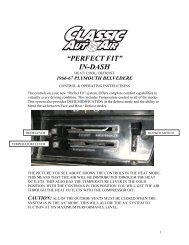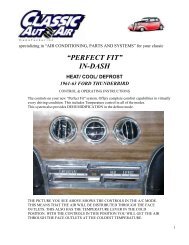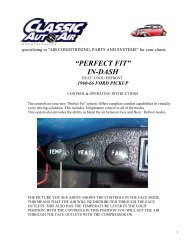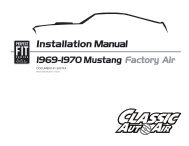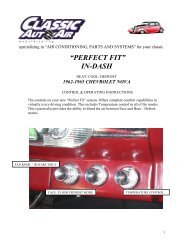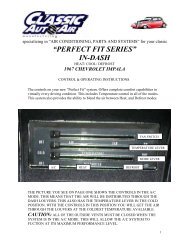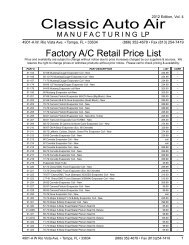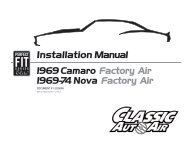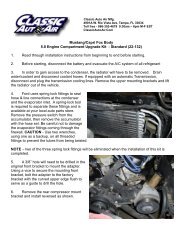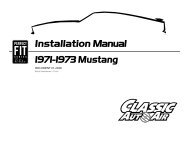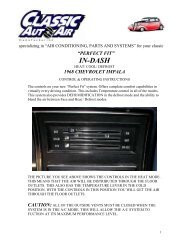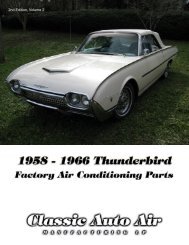1-2066FA INSTALL INSTRUCTIONS - Classic Auto Air
1-2066FA INSTALL INSTRUCTIONS - Classic Auto Air
1-2066FA INSTALL INSTRUCTIONS - Classic Auto Air
Create successful ePaper yourself
Turn your PDF publications into a flip-book with our unique Google optimized e-Paper software.
PAGE<br />
37<br />
TEST CONDITIONS USED TO DETERMINE SYSTEM OPERATION<br />
(THESE TEST CONDITIONS WILL SIMULATE THE AFFECT OF<br />
DRIVING THE VEHICLE AND GIVE THE TECHNICIAN THE THREE<br />
CRITICAL READINGS THAT THEY WILL NEED TO DIAGNOSE ANY<br />
POTENTIAL PROBLEMS).<br />
B. CONNECT GAUGES OR SERVICE EQUIPMENT TO HIGH/LOW<br />
CHARGING PORTS.<br />
C. PLACE BLOWER FAN SWITCH ON MEDIUM.<br />
D. CLOSE ALL DOORS AND WINDOWS ON VEHICLE.<br />
E. PLACE SHOP FAN IN FRONT OF CONDENSER.<br />
F. RUN ENGINE IDLE UP TO 1500 RPM.<br />
ACCEPTABLE OPERATING PRESSURE RANGES (R134A TYPE)<br />
1. HIGH-SIDE PRESSURES ( 150-250 PSI ) *Note- general rule of thumb is<br />
two times the ambient (daytime) temperature, plus 15-20%.<br />
2. LOW-SIDE PRESSURES ( 15-25 PSI in a steady state).<br />
CHARGE AS FOLLOWS: R134A = 24 OZ.<br />
NO ADDITIONAL OIL IS NECESSARY IN OUR NEW COMPRESSORS.<br />
TYPICAL PROBLEMS ENCOUNTERED IN CHARGING SYSTEMS<br />
NOISY COMPRESSOR. A noisy compressor is generally caused by charging a compressor with<br />
liquid or overcharging<br />
A. If the system is overcharged both gauges will read abnormally high readings. This is<br />
causing a feedback pressure on the compressor causing it to rattle or shake from the<br />
increased cylinder head pressures. System must be evacuated and re-charged to exact<br />
weight specifications.<br />
B. Heater control valve installation - Installing the heater control valve in the incorrect hose.<br />
Usually when this occurs the system will cool at idle then start to warm up when raising the<br />
RPM’s of the motor. THE HEATER CONTROL IS A DIRECTIONAL VALVE; MAKE SURE THE<br />
WATER FLOW IS WITH THE DIRECTION OF THE ARROW. As the engine heats up that water<br />
transfers the heat to the coil, thus overpowering the a/c coil. A leaking or faulty valve will<br />
TROUBLESHOOTING GUIDE<br />
have a more pronounced affect on the unit’s cooling ability. Installing the valve improperly<br />
(such as having the flow reversed) will also allow water to flow through, thus inhibiting<br />
cooling. Check for heat transfer by disconnecting hoses from the system completely. By<br />
running down the road with the hoses looped backed through the motor, you eliminate the<br />
possibility of heat transfer to the unit.<br />
C. Evaporator freezing - Freezing can occur both externally and internally on an evaporator<br />
core. External freeze up occurs when the coil cannot effectively displace the condensation<br />
on the outside fins and the water forms ice (the evaporator core resembles a block of solid<br />
ice), it restricts the flow of air that can pass through it, which gives the illusion of the air not<br />
functioning. The common cause of external freezing is the setting of the thermostat and the<br />
presence of high humidity in the passenger compartment. All door and window seals should<br />
be checked in the event of constant freeze-up. A thermostat is provided with all units to<br />
control the cycling of the compressor.<br />
D. Internal freeze up occurs when there is too much moisture inside the system. The<br />
symptoms of internal freeze up often surface after extended highway driving. The volume of<br />
air stays constant, but the temperature of the air gradually rises. When this freezing occurs<br />
the low side pressure will drop, eventually going into a vacuum. At this point, the system<br />
should be checked by a professional who will evacuate the system and the drier will have<br />
to be changed.<br />
E. Inadequate airflow to condenser - The condenser works best in front of the radiator with<br />
a large supply of fresh air. Abnormally high pressures will result from improper airflow.<br />
Check the airflow requirements by placing a large capacity fan in front of the condenser<br />
and running cool water over the surface. If the pressures drop significantly, this will indicate<br />
the need for better airflow.<br />
F. Incorrect or inadequate condenser capacity - Incorrect condenser capacity will cause<br />
abnormally high head pressures. A quick test that can be performed is to run cool water<br />
over the condenser while the system is operating, if the pressures decrease significantly, it<br />
is likely a airflow or capacity problem.<br />
G. Expansion valve failure - An expansion valve failure is generally caused by dirt or debris<br />
entering the system during assembly. If an expansion valve fails it will be indicated by<br />
abnormal gauge readings. A valve that is blocked will be indicated by high side that is<br />
unusually high, while the low side will be unusually low or may even go into a vacuum. A<br />
valve that is stuck open will be indicated by both the high and low pressures rising to<br />
unusually high readings, seeming to move toward equal readings on the gauges.<br />
H. Restrictions in system - A restriction in the cooling system will cause abnormal readings<br />
on the gauges. A high-side restriction ( between the compressor and the drier inlet ) will be<br />
indicated by the discharge gauges reading excessively high. These simple tests can be<br />
performed by a local shop and can help determine the extent of the systems problem.<br />
www.classicautoair.com • 866.435.7801



